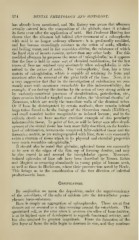Page 564 - My FlipBook
P. 564
574 DENTAL EMBRYOLOGY AND HISTOLOGY.
has already been mentioned, and Mr. Rainey was aware that albumen
actually entered into the composition of the globule, since it retained
its form even after the application of acid. But Professor Hasting has
shown that the albumen left behind after treatment of a calcospherite
with acid is no longer ordinary albumen : it is profoundly modified,
and has become exceedingly resistant to the action of acids, alkalies,
and boiling water, and in fact resembles chitine, the substance of which
the hard skin of insects consists, rather than any other body. For this
modified albumen he proposes the name of ' calcoglobulin,' as it appears
that the lime is held in some sort of chemical combination, for the last
traces of lime are retained very obstinately when calcoglobulin is sub-
mitted to the action of acids. The ' calcospherite,' then, has a true
matrix of calcoglobulin, which is capable of retaining its form and
structure after the removal of the great bulk of the lime. Now, it is
a very suggestive fact that in the investigation of calcification Ave con-
stantly meet with structures remarkable for this indestructibility ; for
example, if we destroy the dentine by the action of very strong acids or
by variously-contrived processes of decalcification, putrefaction, etc.,
there remains behind a tangled mass of tubes, the ' dentinal sheaths ' of
Neumann, which are really the immediate walls of the dentinal tubes.
Or if bone be disintegrated by certain methods, there remain behind
large tubes found to be the linings of the Haversian canals (Kolliker),
and small rounded bodies recognizable as isolated lacunte ; and in the
culicula dentis Ave have another excellent example of this peculiarly
indestructible tissue. In point of fact, as will be better seen after devel-
opment of the dental tissue has been more fully described, on the border-
land of calcification, between the completed, fully-calcified tissue and the
formative matrix, as yet unimpregnated with lime, there very constantly
exists a stratum of tissue which in its physical and chemical properties
very much resembles calcoglobulin."
It should also be noted that globular, spherical forms are constantly
to be seen at the edges of the thin cap of forming dentine, and may
be also traced in and around the interglobular sj^aces. Moreover,
isolated spherules of lime salt have been described by Messrs. Robin
and INIagitot as occurring abundantly in young pulps of human teeth,
as well as those in Herbivora, where their presence was noted by Henle.
This brings us to the consideration of the first division of calcified
products—viz. bone.
Ossification.
By ofiftifionfinn we mean the deposition, under the superintcndency
of the osteoblasts, of the salts of calcium into the intercellular proto-
plasmic basis-substance.
Bone is simply an aggregation of calcospherules. These are at first
thrown out or secreted as a thin covering around the osteoblasts. The
specialized coll, at the time when it assumes the office of bone-builder,
is at its highest state of development as regards functional activity, and
has also attained its greatest magnitude. From the formation of the
first layer of bone the cells begin to decrease in size, and they continue


